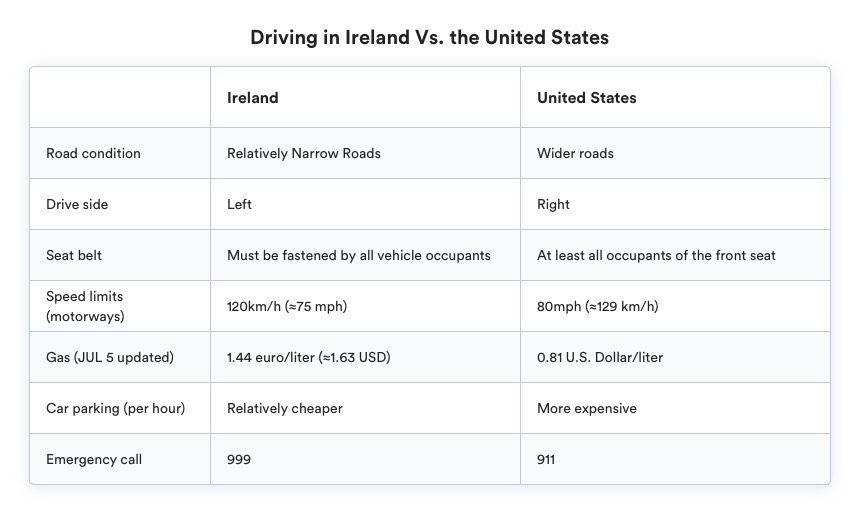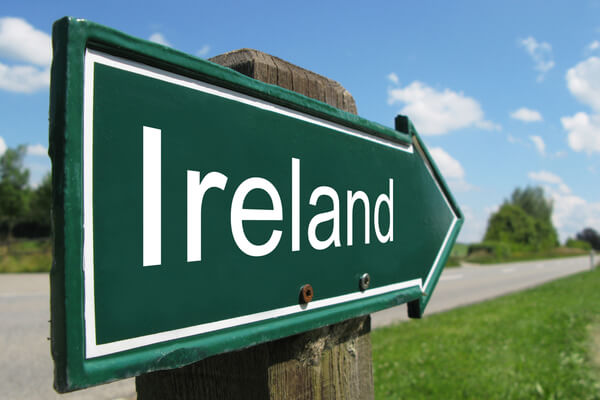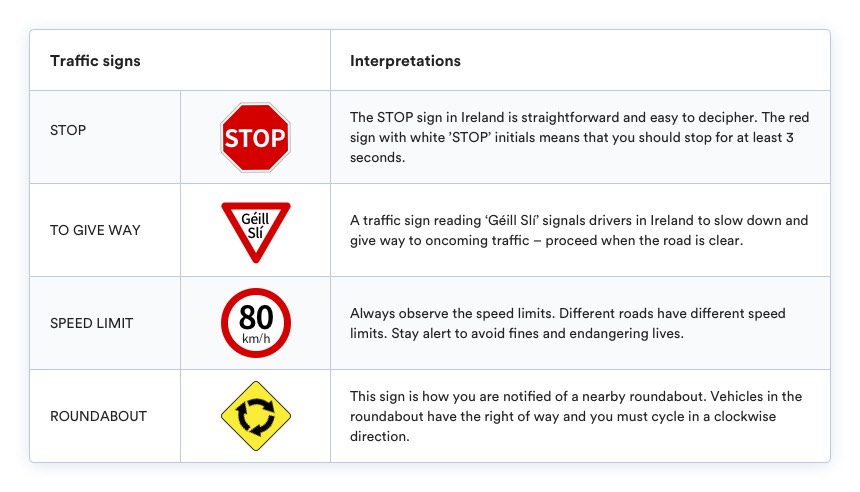Traveling in Ireland is a sight for sore eyes, from the inspiringly beautiful landscape to friendly locals. And what better way to experience the scenery than traveling by car at your own pace? Renting a car allows you to explore Ireland beyond the online description. However, driving in a new country can be a daunting experience for foreign drivers, so a thorough understanding of the rules of the road in Ireland is crucial. The following comparison table highlights the basic concept of driving in Ireland by comparing the most noteworthy differences between driving in Ireland, and the United States.
The 4 sections below expound on the comparative table by exploring everything you need to know when driving in Ireland, including the driving rules, road conditions, petrol (gas), and parking norms. Read on for our detailed Irish driving guide and learn how reliable professionals at QEEQ.COM can help you enjoy your driving experience!
1. Driving Rules
- Driving Side
You should always keep to the left unless overtaking! ’A right turn is wide, and a left turn is tight’ – make sure this tip is imprinted in your brain when making a turn. However, if you are from a country that drives on the right, feel free to take test runs on isolated roads to get your mind accustomed to the new driving system. It is also worth noting that you are more susceptible to making a traffic mistake if you are sleepy, tired, or transitioning to a different road layout – so be mindful of events or situations when your mind subconsciously snaps back to your usual driving practice.
Another important fact to keep in mind is that most cars in Ireland are stick shifts and the driver’s seat is on the right. Therefore, if you’re not comfortable driving a manual car and changing gears with your left hand, we recommend you head over to an online car rental platform and reserve an automatic transmission car as early as possible.
Expert Tip: Try switching your watch to the other wrist to help rewire your brain to the ’mirror image’ of driving on the left side – it works as a constant reminder!
- Speed Limits
Regardless of your country of origin, speed limits are a strict traffic rule that must be observed! But did you know that Ireland and some other European countries use Kilometers/hour rather than miles/hour (as practiced in the United States)? To help you grasp the different speed metrics, one mph roughly equates to 1.6 km/h. The following speed limits apply to different roads in Ireland:
i. Urban areas– 50 km/h (31 mph): Built-up areas within cities and populated towns.
ii. Regional and local roads (single open) – 80 km/h (50 mph): Small roads that connect villages and small towns.
iii. Motorways– 120 km/h (75 mph): Multilane roads often leading in and out of major cities.
iv. National roads– 100 km/h (62 mph): Primary or secondary roads that link some of the major cities in Ireland.
Expert Tip: Remember, the speed limit is not a goal to work towards – don’t feel pressured. Keep your driving speed under control by driving slowly, especially if you are not accustomed to the traffic rules!
- Traffic Signs
Road markings and traffic signs in Ireland are categorized into regulatory, warning, and information traffic signs. Below are some traffic signs that are essential to your driving experience, along with their interpretation (NB: It is advisable to review all the traffic signs as per the Irish Rule Book).
For more information about Irish road signs, here is an infographic from QEEQ.COM.
A fun fact: Roundabouts are quite common when driving in Ireland. If you are from the United States, you might be shocked by the numerous roundabouts at nearly every crossroad!
- Penalties
Imagine saving up for a vacation or taking some time off your business meetings in Ireland to explore the country, only to end up accruing fines as high as $450. This might be your fate if you drink and drive! Sure, the country is known for its famous alcoholic breweries/brands and drinking holidays, but very few people (if any) will risk driving after a night out. In the Republic of Ireland, local police officers (Gardai) randomly stop vehicles for alcohol testing. If your alcohol content is higher than 0.5 milligrams per milliliter of blood, you might have to part with 200-400 Euros ($225-450).
Below are some additional traffic fines that apply in Ireland – to bring the importance of safe driving into perspective:
i. Breaking roundabout rules: 60 Euros ($70)
ii. Unfastened seat belt: Always fasten your seat belt! Aside from risking the lives of the occupants, not wearing a safety belt leaves you liable to a fine of 60 Euros ($70)
iii. Driving beyond the speed limit: 80 Euros ($90)
- Other Golden Driving Tips in Ireland
i. Right of way: Cars on the beltway, roundabouts, and those come coming from the right side of an unmarked crossing have the right of way, but always stay alert and utilize defensive driving if necessary.
ii. Keep your near lights on! Similar to other nations in the European Union, vehicles are required to keep their near lights on, regardless of the time.
iii. Don’t hold your smartphone while navigating! Use a voice-assisted GPS instead of physically interacting with your smartphone navigation APP. The law is quite strict on the use of mobile phones while driving. Alternatively, ensure you have a designated navigator (passenger) or simply pull over to confirm your route.
iv. Be aware! Some driving rules in Northern Ireland are different from those in the Republic of Ireland: Since Northern Ireland and the Republic of Ireland are different countries, there is a slight difference in the traffic laws. For example, the speed limits slightly change when you cross into Northern Ireland (70 mph on dual carriageways, 60 mph on single carriageways, and 30 mph in urban areas).
2. Road Conditions and Toll Roads
- How Hard is it to Drive in Ireland?
Have you ever noticed in news segments and films that most Europeans drive small cars? Well, there is a simple explanation for this practice – most European roads are characteristically narrow. To illustrate, some Irish roads such as the N78 have an occupancy space of 7.4 feet (2.25 meters) and a hard shoulder of as little as 9 inches. In comparison, vehicle lanes in the United States have a width of between 9 and 15 feet – the highway standard is 12 feet. Therefore, it is advisable to rent a smaller car during online reservation for easier navigation, but make sure that it can accommodate your passengers and luggage.
In addition to the narrow roads, Ireland has a magnificent landscape that is characterized by mountainous regions with winding roads. While this is a setting for a romantic and relaxing experience, the curves and turns might be a safety hazard – it is best to drive slowly. It is also advised to be on the lookout for unexpected obstructions such as sheep, especially on local roads in the countryside.
- Toll Roads
Drivers using certain roads are required to pay a certain fee, which is usually allocated to help maintain the roads. Payment methods include:
i. Cash or Card: There are eleven toll roads in the Republic of Ireland. In ten of these roads (M50 excluded), you are expected to carry cash (mostly coins) to pay at the respective barrier toll plazas.
ii. Barrier-free tolling system: The M50 motorway in Dublin uses a barrier-free tolling system (eFlow operator) – it’s the only toll road that doesn’t require you to stop. Traffic cameras record the license plate number of vehicles and drivers are expected to pay their tolls by calling 1890 50 10 50 or through this online platform.
Expert Tip: Brace yourself for a truckload of traffic cameras – say cheese! 😁
3. Car Fuel
To avoid getting stranded in the middle of nowhere, ensure you understand a few fueling tricks and tips as follows:
- Do you know the type of fuel used by your rental car? It is also important to note that a green gas pump handle represents unleaded petrol, unlike in the U.S. where it stands for diesel. If you make the mistake of pumping the wrong gas, avoid starting the car and reach out to your rental company.
- Ensure you are conversant with the demographics and distribution of ’petrol stations’ in your driving route. To stay safe, always refill when the tank is half empty/half full and don’t wait until the D-day. Additionally, if you plan to travel at night, take note that some gas stations don’t offer 24-hour services.
- What about prices? The cost of gasoline is maintained under the international oil prices. Approximately, you need around 1.50 euros (roughly $1.70) per liter. Although most gas stations accept credit cards, carry some cash for peace of mind.
Expert Tip: While ’gas’ refers to petrol or diesel in the United States, it refers to LPG, natural, or propane gas used for heating/cooking in Ireland!
4. Parking
In the Republic of Ireland, there are traditional and metered parking spaces, with the latter attracting an hourly fee of 0.8-2.9 Euros ($0.9-3.2) depending on the location.
If you are not sure whether you are allowed to park in a certain zone, don’t hesitate to ask a local – avoid unnecessary fines. Dangerous traffic violations such as parking in a clearway or within a double yellow line might attract a fine of up to 95 Euros ($105).
Expert Tip: Click here to find parking locations nearby!
Final Thoughts
With these driving tips at your disposal, you should feel free to explore the ’Emerald Isle’ without the fear of unnecessary safety hazards or hefty fines from traffic violations.
Visit QEEQ.COM now.
QEEQ.COM guarantees the most competitive car rental deals for your travel and the secret is our Price Drop Protector program! We can automatically track your rental rates and RE-BOOK you if prices drop! See how our customers love this feature here.



